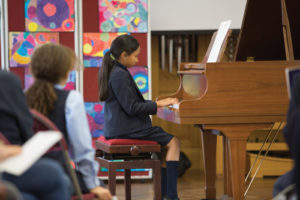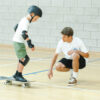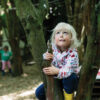
by Claudine Lacroix
The Mindful Me Club
How can mindfulness help you and your family deal with the increasing pressures of modern living.
Time
The clock is ticking, the children aren’t dressed and you find yourself shouting as you are feeling the pressure that you are going to be late for work. How many hours in our day do we run around being driven by the clock? Often it is not until we are on a holiday, perhaps looking at a beautiful sunset or a stunning view that we may allow our minds to stop for a moment of calm, then it may only be a matter of moments before we revert back to being consumed by uncontrollable thoughts and worries of the
past or future. A mind consumed with things we need to do, have done already or think we could have done better, is all too common.
Our children
For our children, it is not uncommon to be stressed as a result of trying to deal with such difficulties as: parents fighting, divorcing or separating, themselves being bullied, undergoing school stress, money worries, a new sibling or fear of the future. For both parent and child, living in this way can cause a lifetime of chronic stress and anxiety that can often lead to many ailments such as insomnia, depression and suppressed immunity.
The body and mind connection
The understanding that stress can induce illness and the impact that our mind has on our health, are certainly not new ideas. It has been recognised for many years in such fields as behavioural medicine, psychoneuroimmunology, hypnotherapy and Chinese medicine that the way that we think and feel, has a significant effect on our physical health. Jon Kabat-Zinn is an American professor of medicine and the creator of the Stress Reduction Clinic and recognised for his extensive work using mindfulness with patients to relieve stress, pain, anxiety and illness. His book, ‘The Full Catastrophe’ provides an in-depth background to mindfulness and it’s benefits on the body.
So, you might be asking what is mindfulness and how can it help my family and I?
Mindfulness is an effective, yet simple practice that involves the repetition of basic techniques including conscious breathing, movement and listening. It is done in a self-directed training programme and results in developing greater acceptance and awareness of the present moment. As a result of repeated practice, a sense of calm, self-acceptance and a change of perspective can occur benefiting both mind and body. One learns to step back from worried thoughts and stresses, responding rather than reacting to life’s challenges. Children too, can learn techniques to help them to deal with difficult emotions and negative thought patterns. Through teaching some simple facts about the brain and its connection to these thought patterns the children can feel more in control, develop resilience, self-acceptance and emotional awareness. Children learn that they don’t need to hide or suppress their feelings but can manage and understand them instead. Parents and children can do some of the techniques and mindful activities together, making it part of the family day. The techniques not only include the conscious breathing, listening and moving, mentioned earlier, but also sharing feelings and experiences and talking about them together.
As long as you can breathe and you have the willingness and discipline to practice then that’s all you need. The practice may, at the very least, create a space in your day to relax but it’s also possible, with regular practice, to experience a more constant state of calm that filtrates into all areas of your life and has some noticeable beneficial effects on your health and lifestyle choices. At the very best, you will awaken to the truth and beauty that is available to you in each moment and that could change your life.
Claudine Lacroix is a mother, aromatherapist, English teacher and Mindfulness practitioner having recently studied humanistic counselling at the Gestalt Centre, London. Claudine provides mindfulness classes in local primary schools, private classes outside of school hours and provides one to one sessions with adults, teenagers and children.
Claudine Lacroix runs The Mindful Me Club – to find out more or book a class in Brighton call 07341 565 445 or email themindfulmeclub@gmail.com or visit Facebook page: The Mindful Me Club.


 This journey of broad discovery essentially starts at primary and indeed pre-primary level and provides all children with the opportunity to seek out and explore areas of interest and to develop talent which provide many with a lifelong love of learning. Over the years I have spoken to many parents whose main requirement, when considering the options for their children, is to ensure their children are happy. Happiness and thus mental health are of key importance in a world of increased pressure and expectations. Children supported and nurtured and indeed loved within their school will automatically have a head start and hopefully will develop a hunger for knowledge. Of course the breadth of study and the balance of the curriculum is also key and provides the option for all to explore their individual burgeoning interests. All children develop academically at a different pace. On many occasions I have had to reassure anxious parents that their child is not a failure because they are struggling with their spellings or their fractions. These are just moments in time in the life of a young person and should not be the basis of perceived success nor failure.
This journey of broad discovery essentially starts at primary and indeed pre-primary level and provides all children with the opportunity to seek out and explore areas of interest and to develop talent which provide many with a lifelong love of learning. Over the years I have spoken to many parents whose main requirement, when considering the options for their children, is to ensure their children are happy. Happiness and thus mental health are of key importance in a world of increased pressure and expectations. Children supported and nurtured and indeed loved within their school will automatically have a head start and hopefully will develop a hunger for knowledge. Of course the breadth of study and the balance of the curriculum is also key and provides the option for all to explore their individual burgeoning interests. All children develop academically at a different pace. On many occasions I have had to reassure anxious parents that their child is not a failure because they are struggling with their spellings or their fractions. These are just moments in time in the life of a young person and should not be the basis of perceived success nor failure. Confidence is key together with a large dose of resilience. So your child isn’t going to win a Spelling Bee! But watch them play their musical instrument with pride and courage or hear them sing in front of an admiring audience. Look at their artwork and wonder at their developing sensitivity. Stand back in awe at their prowess on the hockey field and feel proud at their selfless teamwork and support for others. Marvel at their enthusiasm for their castle project in history or their ability to recite verse in French or Spanish. And admire them on the stage in the school production as a child you barely recognise as the one who you take home every day from school!
Confidence is key together with a large dose of resilience. So your child isn’t going to win a Spelling Bee! But watch them play their musical instrument with pride and courage or hear them sing in front of an admiring audience. Look at their artwork and wonder at their developing sensitivity. Stand back in awe at their prowess on the hockey field and feel proud at their selfless teamwork and support for others. Marvel at their enthusiasm for their castle project in history or their ability to recite verse in French or Spanish. And admire them on the stage in the school production as a child you barely recognise as the one who you take home every day from school! gether
gether










